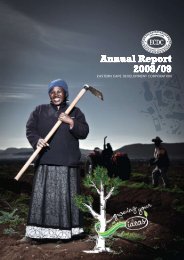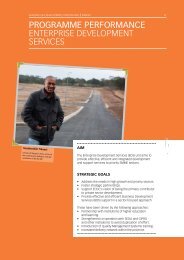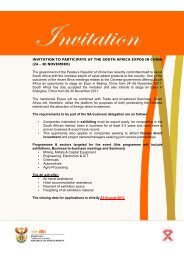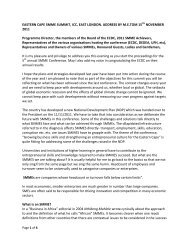Amathole Tourist Guide AWp - Eastern Cape Development ...
Amathole Tourist Guide AWp - Eastern Cape Development ...
Amathole Tourist Guide AWp - Eastern Cape Development ...
- No tags were found...
Create successful ePaper yourself
Turn your PDF publications into a flip-book with our unique Google optimized e-Paper software.
The <strong>Amathole</strong> Heritage InitiativeMAP KEY= Phalo Route= Maqoma Route= Sandile Route= Makana/Coastal Route1
AMATHOLE HERITAGE INITIATIVEINFORMATION ON HERITAGE SITES ON THE ROUTES:MAKANA, MAQOMA, SANDILE & PHALOIntroduction to the heritage sites:There are few places in the world where the complicated concept of a ‘Frontier’ can bebetter shown than in the <strong>Eastern</strong> <strong>Cape</strong>. For 100 years (1779-1878) the Xhosa peopleput up a tenacious resistance to European encroachment and the evidence of thisstruggle still exists in many evocative sites. No area in Southern Africa, and possibly theworld, is there such a density of military and mission sites. To these have been addedmemorials to the more modern struggle victims, as so many the leaders have their rootsin the <strong>Eastern</strong> <strong>Cape</strong>.The ‘Frontier’ can be explored as more than just a struggle for the land or as a collectionof military sites, missions and graves. It encompasses an era of social, religiousinteractions and economic change and the evidence is there for those with eyes to see.Where were the forts situated? What did the missionaries contribute? How did theseaffect settlement patterns and lifestyles? Visit the sites, find out more about them andmake you own judgements.Heritage sites, which can be seen on the Routes, encompass pre-colonial life, an era ofconflict, mission and educational work and the achievements of individuals. They areevocative, not only in terms of the past, but also in deepening an understanding of thepresent.1 MAKANA ROUTE:Introduction:Makana, often known as ‘Nxele’, was born in the late 18 th century. He was a person ofgreat magnetism and energy. He gained a reputation as a prophet, diviner and wardoctorand gathered a large following. He was very interested in Christianity andsupported many of its values, but later in life, he became disillusioned and turnedagainst it. He had a strong belief in his own powers and in 1817 he attempted todemonstrate these by gathering his followers at Cove Rock (Gompo) where he saidthey would witness the resurrection of their ancestors and cattle. Even when this didnot happen he retained his credibility. He supported Ndlambe in his conflict with Ngqikaand took part in the Battle of Amalinde. His anger at the action of Somerset inburning huts and taking cattle as retribution on behalf of Ngqika led him to work withNdlambe and lead the attack on Grahamstown in 1819. The force of 10 000 warriorswas unable to break through the guns of the defenders. Makana was captured and sentto Robben Island. He attempted to escape in 1820, but the boat overturned and he was2
drowned. His followers refused to believe that he was dead and waited for many yearsfor his return.Sites:BISHO MASSACRE MONUMENTIn 1992 a group of about 40 000 ANC and SACP membersmarched on Bhisho, demanding that the Ciskei Homeland beabolished and Brigadier Oupa Gqozo, then Ciskei president,resign. A combined unit of Ciskei and SA National DefenceForce soldiers intercepted the march and fired into the crowd,killing 29 people and wounding many others.STEVE BIKO GARDEN OF REMEMBRANCE:Bantu Stephen (Steve) Biko was born in 1946 in King William’sTown. He identified the concept of Black Consciousness, whichadvocated that black people should be proud of their ‘blackness’and their heritage. He founded the South African Student’sOrganisation (SASO) in 1968 and the Black People’s Convention(BPC) in 1972. While he was working for the Black CommunityProgramme, initiated by the S.A. Council of Churches in Durbanin 1973, he was banned and restricted to King William’s Town.There he founded the <strong>Eastern</strong> <strong>Cape</strong> Branch of the BCP. He wasarrested and detained in 1976. In 1977 he was arrested againand sent to Port Elizabeth for questioning and was seriouslyinjured. He died in September 1977 of a brain haemorrhage. Steve Biko was a man ofgreat charm and intelligence and an outstanding orator. An untiring and outspokenopponent of apartheid, his death sent shock waves around the world and re-enforcedinternational opposition to the apartheid regime. Steve Biko’s grave is in the Garden ofRemembrance.DIMBAZAThe apartheid government laid out this township in an effort to create an industrial areaand provide spaces for resettlement. As it was an artificial construct, it never worked,but many people still live there among the remains of factories, long since gone.3
NTABA KANDODAThis mountain near Debe Nek was named for aKhoi chief, Ndoda, who lived in the area duringthe 1700s. Rharabe killed him in a battle forland, when Rharabe moved west over the Keiafter a disagreement with his brother, Gxaleka.Ndoda’s wife, Hoho, was given land by Rharabe,and the mountain behind Pirie Mission still bearsher name. During the Ciskei homeland period,Sebe had a large shrine built on Ntaba kaNdodain 1981, intending it to be a monument to theXhosa chiefs who had died in the struggleagainst the dispossession of their lands. With the fall of Sebe and the removal of the‘homeland’ status of the Ciskei, the building was abandoned and has since beenvandalised.FORT WHITEThis was a star-shaped earthwork fort, whichwas built in 1835 and intended to garrison 10cavalry and 15 British infantry soldiers as wellas 15 Khoi infantry. It was intended to be alink in the line of forts built along the edge ofthe <strong>Amathole</strong> Mountains where the Xhosawarriors were able to hide so successfully. Itwas named for Major T.C. White who waskilled in an engagement near the MbhasheRiver. Fort White was abandoned in the late1830s but relocated in 1852 with most buildings of wattle and daub, but with a stonemagazine. It came under attack but was not taken. The remains of the ditches andearthen mounds are all that remain today.FORT COXThis was part of the 1835 series of fortificationsplanned by Sir Benjamin D’Urban and situated on a riseclose to the <strong>Amathole</strong> Mountains. It was built ofearthworks and stone but the construction wascontinually held up by attacks by raiding Xhosawarriors. It was named for Major William Cox of the71 st Regiment. It was re-occupied and enlarged duringthe War of the Axe and became one of the permanentposts, providing a hospital, magazine and commissariatas well as quarters for soldiers. Fort Cox was besiegedby the Xhosa in 1850 while Sir Harry Smith was there.4
Smith managed to escape, but was very angry at the perceived insult. The fort wasdismantled in 1858 and little remains today.BATTLE OF GWANGQAA large British military presence was stationed at Fort Peddie during the War of the Axe.In June 1846 Xhosa and British forces battled it out on the banks of the Gwangqa River.The Xhosa retired, as they did not have the artillery to match that of the British.PEDDIE:A fort was built at Peddie as part of the fortification of1835. It was named for Lt. Col. John Peddie of the72 nd regiment. It was originally a star-shapedearthwork fort surrounded by ditches. Substantialstone buildings were erected to house the soldiersand horses. Parts of the BARRACKS and STABLESstill remain but have been converted into offices.WATCHTOWER:Situated at a little distance from the fort on the highest point in the area is theWATCHTOWER. This was one of a series of nine signal towers, erected in 1843-44, in avain effort to keep the various forts in touch by means of signal mirrors. The one lineextended from Grahamstown to Fort Beaufort and one east to Fort Peddie. They weresubstantial stone structures originally equipped with semaphoring devices, but wereisolated and so troops stationed there could not get water or food in times of trouble.In addition the devices never worked, so they proved to be useless.MILKWOOD TREE:The Mfengu people took refuge west of theMzimvubu River during the time of the Zulu KingShaka. They settled among the Gxaleka but werenot totally accepted. They were promised land bythe British in 1834 and in return fought on theside of the British and colonial forces. To escapethe anger of King Hintsa and the Gxaleka clan,they persuaded the colonial government to givethem land west of the Kei River. They wereallocated land in the Peddie area and a party of 17000 men, women and children with 22 000 head of cattle (many taken from theGxaleka) moved there. A ceremony was held under a milkwood (umgwashu) tree in1838, where they swore an oath of loyalty to the British crown.5
FORT WILLSHIREThe original fort was planned by Governor, Lord CharlesSomerset to guard a drift over the Keiskamma River,following the attack on Grahamstown in 1819. The ActingGovernor, Sir Rufane Donkin visited the construction workwhile Somerset was away on leave. He noted the lack ofaccess to water and changed the site. What became knownas the Keiskamma Barracks was then built closer to theriver. Donkin wished to promote good relations with theRharabe and an agreement was made that trade could becarried on at Fort Willshire. Somerset then imposedstringent conditions, but the trade fairs proved to be a greatsuccess between the years 1824 and 1830. Ivory and hideswere purchased from the Xhosa with textiles, beads, cooking utensils and agriculturalimplements being bought by them. Following the war of 1834-35, the fort wasabandoned and most of the stone carted away for other purposes.6
2 MAQOMA ROUTEIntroduction:Maqoma, born in 1798, was the eldest son of the Rharabe King, Ngqika, but of the RightHand House, so not in direct line of succession. As a young man he established hishousehold in the Winterburg in the so-called ‘Neutral Territory’ in 1821. He wasstrongly opposed to the extension of the colonial frontier and consistently andsuccessfully raided cattle of the white settlers. This brought him into conflict with themagistrates and in 1829 his homestead was captured, his cattle seized and he wasforced to move east of the Kabusie River. King Ngqika died in 1829 and Maqomabecame Regent as Sandile, son of the Great House, was still only a boy. He foughtresolutely in the 1834-35 frontier war and gained status as a powerful and capableleader of the Rharabe. Sandile came of age in 1840 and Maqoma lost his position andthis, together with the colonial incursions, made him very depressed, and he began todrink heavily. He returned to his land in the Waterburg in 1848 and continued cattleraiding to great effect. He regained his old fire during the 1850-53 war and took part inthe Cattle Killing. For this he was exiled to Robben Island until 1869. His freedom wasshort-lived and he was sent back in 1871, dying two years later. He was buried on theisland. His remains were disinterred in 1978 and reburied on Ntaba kaNdoda.Sites:FORT HAREThe original fort wasbuilt in 1847 at theend of the War of theAxe. It was namedfor Lt. Col. JohnHare, who becameActing LieutenantGovernor of the<strong>Eastern</strong> Province in1838 and whocommanded aregiment in 1846. Itremained a Military Reserve until 1882 when part was given to Lovedale and part to thetown of Alice.7
LOVEDALEIn 1824, a small mission stationwas established on the IncehtaRiver by Ross and Bennie andnamed Lovedale in thefollowing year after Dr Love,secretary of the GlasgowMissionary Society, who hadjust died. A church was builtand a school started in 1826and Dr Bennie began compilinga dictionary of Xhosa grammar.The property was destroyed in1835 and it was decided torebuild where water was morereadily available. It wasdecided that Lovedale should offer higher education as well as a seminary. The newbuilding was opened in 1841 With Rev. William Govan as first principal. At the outsetthere was no racial segregation and white and black attended the institution together.The excellence of education was recognised and the enrollment grew steadily. TheLovedale Printing Press, which printed and bound books in Xhosa on a variety ofsubjects, was opened in 1861. After Dr James Stewart took over in 1870, the classicaleducation offered was changed to industrial training, with carpentry, farming, bookbindingetc being taught. It was expanded further in the late 19 th century and ahospital opened. White attendance fell away then, as Lovedale was not recognised as atraining institution for white teachers. Lovedale became a leading light in blackeducation and the South African Native College, later Fort Hare University, was aproduct of Lovedale. In 1953 the Bantu Education Department took over and standardsdeclined drastically. Lovedale was closed in 1979, but re-opened as a college forcontinuing education in 1989. In 1994 it was further developed and redefined as acentre for skills training.8
NKONKOBE GARDEN OF REMEMBRANCESituated in Alice, this is a memorial to thosewho lost their lives in the struggle forfreedom.FORT BEAUFORT was established as a military post in 1822 in order to counter thecontinual raids by Maqoma. It became the centre of action during the 1834-35 frontierwar and it was decided to construct strongfortifications there. The OFFICERS’QUARTERS still remain.It was also decided to construct aMARTELLO TOWER there. This was afortification used in Europe as a coastaldefence system, but strangely, it was thoughtto be suitable for colonial conditions. It is acircular dressed stone tower which originallyhad a swivel cannon mounted on the top. Itwas maintained by the military until 1869.[Proclaimed a National Monument in 1939]HEALDTOWNThis was a Methodist Mission which wasfounded in 1855. It grew to be an importanteducational centre with a very high standardof education. Its reputation attractedscholars from all over South Africa, elsewherein Africa as well as the UK. It offered a HighSchool, a Teacher Training College and aVocational Training Centre as well asboarding facilities. It was taken over by thegovernment in 1956 and the fine missioneducational system destroyed. TheVocational Training Centre was closed. The Ciskei government took over in 1977 andclosed the school leaving the buildings to be vandalised.9
FORT FORDYCEIn an effort to challenge the Xhosa in theirstronghold of the Waterkloof, it was decided to builda fort where routes through the mountains could becontrolled. Completed in 1853, it was a squarebuilding with bastions on the opposing corners.While some stone was used, most of the buildingswere of wattle and daub. As it was cold and windyon the exposed ridge, the soldiers called it MountMisery. It was named for Lt. Colonel Fordyce whohad been killed near the site.POST RETIEFThis stone fort was built near a drift on the KoonapRiver on a farm once owned by Piet Retief. It hadsome substantial stone buildings within a squareencampment. Barracks, a guardhouse, a powdermagazine and stables provided accommodation.FORT ARMSTRONG:This square stone tower is all that remains of amuch larger fortification, originally called CampAdelaide. It was part of the system of fortificationsconstructed in 1835. During the 1850-53 war, thelocal Khoi, mostly settled in the Kat River valley,rose against the colonial government. Under theirleader, Uithaalder, they expelled (unharmed) thelocal white settlers who had taken refuge there andset it up as their headquarters. Later two colonialforces converged on them. They fought bravely butwere all killed. The fort was destroyed by artilleryfire, with only the main tower remaining.DUTCH REFORMED CHURCHThis church in Balfour was started in 1832 to servethe residents of the Kat River settlement with theRev. W. Thomson as first minister. Althoughinitiated by the Church of Scotland, it was handedover to the Dutch Reformed Church, who continuedto administer it and started a school.10
PHILIPTON MISSIONIn 1830, James Read began a small school also toserve the Kat River residents in the small village ofPhilipton. It was then recognised as a mission byDr Philip of the London Missionary Society. Rev.Read’s two daughters assisted him and started anInfants’ school and a Sewing School, which wererun very successfully. The school went on to teachat a secondary level and many of the scholarstaught in the surrounding areas.OLIVE SCHREINER’S HOUSEOlive Schreiner was born in 1855, the daughter of amissionary who came to South Africa, originallyunder the auspices of the London MissionarySociety. The family moved to Hertzog when shewas still a child. Although she had little formaleducation, she became a governess to variousfamilies who lived in the Karoo. It was while shewas with one of these families that she wrote TheStory of an African Farm. Published in 1883, it made her into a famous author. Shewas strongly opposed to Rhodes’s imperialism and believed in non-racism. She was anearly supporter of women’s rights and her book, Women and Labour, became a classicof its kind. She died in 1920.NTSIKANA’S GRAVENtsikana was a contemporary of Makana and alsoa seer who had mystical revelations. He alliedhimself with Ngqika. He adopted Christiantheology emphasising the ideals of peace andsubmission. Like Makana, he tried to make senseof a changing world, but on different terms. Hecomposed many Xhosa hymns. He died in 1821.11
ELAND’S POSTIn 1830 a small post of wattle and daub was erected onthe Elands River, a small tributary of the Kat River. Itwas intended to guard the entrance to the Tyumevalley. It was extended in 1837 to accommodate 20soldiers and their horses. It fell to the Kat River Khoifor a short time during the War of Mlanjeni. The villageof Seymour was established in the grounds in 1853.FORT MICHELThis was a post erected of wattle and daub and usedduring the 1850-53 war to control the pass through themountains to the Tyume valley.CHRISTMAS DAY MASSACRE SITEIn an effort to keep the fertile Tyume valley for whiteoccupation, Sir Harry Smith established a chain of so-calledmilitary villages. They were however, never fortified, nor werethe inhabitants armed. With the outbreak of hostilities in 1850,a force of Xhosa, sweeping down from the mountains attackedWoburn. All were killed and the village was burnt. The warriorsthen attacked Juanasburg, but first allowed the women andchildren to leave and take shelter in the mission. Theinhabitants of Juanasburg fled to Fort Hare and this village wasalso burnt.12
3 SANDILE ROUTEIntroduction:King Sandile was the son of King Ngqika and his wife, Suthu, of the Great House. Hewas born in about 1820 and was still a minor when his father died in 1829. Maqomaruled as regent until 1840, when Sandile assumed the mantle of leadership. At first hehad an ambivalent attitude to the colonial forces and concluded treaties with successivegovernors, but was antagonised by their arrogant attitudes. He took part in the War ofthe Axe in 1846 and was captured in 1847. He was forced to sign an oath of allegianceto Britain and was dispossessed of his land. He and his followers were settled on landin the so-called Crown Reserve. His continued opposition led him to participate in theWar of Mlanjeni (1850-53) and to become a ‘Believer’ in the Cattle Killing, whichconsiderably weakened the Rharabe people. In 1877 he entered the war on the side ofthe Gxaleka king, Sarhili, but was killed in a fight which took place near Stutterheim in1878. [See King Sandile’s Grave].Sites:CATTLE KILLING GRAVESAdjacent to the first cemetery in King William’sTown, started in 1848, is the site where casualtiesof the Cattle Killing were buried in mass graves in1857. (See Nongqawuse)PIRIE MSSIONThis mission was founded in 1830 by Rev JohnRoss of the Glasgow Missionary Society andnamed for Alexander Pirie who became secretaryof the society after the death of Dr Love. Themission was attacked in 1834 and the missionariesfled to Burnshill, where Suthu, widow of Ngqika,protected them. The beautiful church is still usedtoday.13
BATTLE OF AMALINDEIn October 1818 the simmering enmitybetween Ngqika and Ndlambe came to a headover Ngqika’s support for the colonial power.Hintsa joined Ndlambe and stirred up byMakana, they provoked a fight. Ngqika’sforces were defeated and this affair led to theoutbreak of the war of 1819.MIDDLE DRIFT:CHIEF KAMA’S GRAVEWilliam Kama was born in about 1798 and was the son ofthe Gqunukhwebe Chief, Chungwa. He was converted toChristianity by the Rev. Shaw at Wesleyville in1823 and hisfaith never wavered. His pro-colonial stance and adoption ofChristianity alienated his elder brother, Chief Phato, andcaused tensions within the clan. Threats led him to move,first to Newtondale, then to the north-eastern <strong>Cape</strong>. In1848 he was given land near Whittlesea where he and Rev.Shepstone established the mission station of Kamastone. Inthe war of 1850-53 he assisted the colonial forces and as areward was given an extensive location at Middledrift. Therethe Methodist mission station of ANN SHAW MISSION was established. He refused totake part in the Cattle Killing so his people did not suffer as badly as most. As a result,many disaffected people joined him and the population of his location grew rapidly.Although not all his followers converted, many did and the Annshaw mission (named forWilliam Shaw’s wife) flourished. Kama died in 1875.14
HOUSE OF PROF D.D.T. JABAVUDavidson Don Tengo Jabavu was born in1885, the eldest son of his well-knownfather, J.T. Jabavu. He attended Lovedaleand then completed his school studies inWales. He obtained a BA degree at LondonUniversity with honours in English. Histeaching diploma was from the University ofBirmingham and he visited many blackeducational institutions in the USA. On hisreturn to South Africa in 1915, he wasThe Jabavu House in Middledriftappointed as lecturer at the South AfricanNative College, later Fort Hare University. He served on the Senate and took a keeninterest in African Studies. He was an accomplished musician and a gifted teacher. Hisservices to higher education were recognised by Rhodes University when he wasawarded LLD honoris causa in 1954. He died in 1959.BURNSHILL WAGON DISASTERThe War of the Axe was started with aggressive actions on the part of the British. Acolumn of cavalry escorting 120 baggage wagons was sent into the <strong>Amathole</strong>s in pursuitof Sandile. They were attacked by the Xhosa and defeated at Burnshill in 1850.KING NGQIKA’S GRAVEKing Ngqika was the son of the Great House of theRharabe Chief, Umlawu. He was born in about 1776. Hisfather died while he was still a young boy and his uncle,Ndlambe acted as regent. Ndlambe did not take kindly tolosing his position when Ngqika came of age and conflictbetween the two was a feature of Ngqika’s reign. Ngqikatried to adopt a non-aggressive approach to the colonialpowers and made some concessions. He appealed toGovernor Lord Charles Somerset for assistance after hisdefeat by Ndlambe at the Battle of Amalinde andSomerset sent a force against Ndlambe. Thisinterference was a direct cause of the war of 1819. Afterthe war, Ngqika agreed that the Neutral Territory,between the Keiskamma and the Kei Rivers could form abuffer zone on the frontier. He died in 1829.15
BOOMAH PASS MEMORIALThis has been called Maqoma’s revenge.After the War of the Axe, Governor Smithheaped humiliation on Maqoma and Sandile.While in Fort Cox (1850), Smith sent a troopof 600 to patrol the <strong>Amathole</strong> Mountains.While passing through the narrow BoomahPass they were ambushed and cut down bythe Xhosa force. The remainder of thedemoralised troop made their way aroundthe mountains to take shelter at Fort White.The memorial was erected in 1853.ST MATTHEWS MISSIONSt Matthews was an Anglican Missionfounded on land given by Chief Socishe in1855. A primary school was started in thefollowing year. In 1875 industrial trainingcourses were introduced, including farming.A hospital and nurses training centre werebuilt in 1923 and a secondary school addedin 1926. The state took over in the 1950sand conditions deteriorated. In 1976 theCiskei government closed down the hospital.St Matthews continues to operate but the facilities are very limited.CASTLE EYREGovernor Cathcart decided that the largeforts were unwieldy so started theconstruction of small temporary posts. Hethought that a central watch tower or ‘castle’would be more effective. Castle Eyre, in thecentre of Keiskammahoek Post was built tohis specifications in 1850. It was a squarebuilding of locally quarried stone, with a flatroof.16
KING SANDILE’S GRAVEKing Sandile was wounded during the frontier war of 1877-78.He was cared for by his followers while he lay in a cave in theIsidenge forest, but died after a few days. The Captain of theBritish forces ordered that his body be found and he wasgiven a ceremonial burial. His body was carried on eight riflesby Mfengu pallbearers and he was laid to rest between twoBritish soldiers killed in the same engagement.17
4 PHALO ROUTEIntroduction:Phalo, the son of Tshiwo, ruled from 1700 to1775. He was the last king of anindependent and united Xhosa nation. WhenPhalo came to the throne, white people werevirtually unknown in Xhosaland, and it isprobably that Phalo only ever saw one whiteman his entire life, the elephant hunterHubner who visited him in 1736. But threeyears after his death, the First Frontier Warbroke out and the Hundred Years War ofXhosa versus Colonist had begun.King Phalo’s grave site at TongwanePhalo was more concerned about the unity of the Xhosa kingdom. While he was livingat this spot, two bridal parties appeared on the same day. One girl was the daughter ofthe King of the Mpondo, and the other was the daughter of the King of the Thembu.Phalo hesitated because he did not know which of the two girls he should take as hisGreat Wife. An old councilor named Majeke solved the problem by creating two housesof equal status. The Great House, descended from the Mpondo girl, is called afterPhalo’s Great Son, Gcaleka. The Right-hand House is called after his Right-Hand son,Rharhabe. Gcaleka and Rharhabe divided Xhosaland between them, with Gcaleka onthe eastern side of the Kei river and Rharhabe on the western side. Phalo himselfresided sometimes on the western side at Izeli and sometimes on the eastern side, justover here. He was buried in 1778.Sites:BATTLE OF UMZINTSHANEThis was the first action of the 1877 war. A group of <strong>Cape</strong>Volunteer Artillery were patrolling near an abandoned tradingstore called Holland’s Shop. On seeing some warriors theyretreated within the walls of the shop. A force of about 1000Gxaleka warriors led by the war chief, Khiva, attacked and keptthe CVA besieged. At the end of the day, and just as theammunition of the defenders was running low, Khiva withdrewhis force.18
TIYO SOGA’S GRAVETiyo Soga was born in 1829 and was the first ordained Blackminister in South Africa. He was first educated at a missionschool of the United Presbyterian Church of Scotland. Hebegan studying theology at Lovedale in 1844, but had to fleeduring the war in 1846. With the assistance of Rev. WilliamGovan, principal of Lovedale, he continued his studies inScotland. He returned to the <strong>Eastern</strong> <strong>Cape</strong> in 1848 workingas a catechist, interpreter and evangelist. He returned toScotland for further study and was ordained a minister ofthe church. He married Janet Burnside and returned toSouth Africa, establishing the Mgwali Mission nearStutterheim. At the request of King Sarhili, he moved to theTranskei in 1868. He was a gifted writer in his own right, butalso translated the gospels of the bible and The Pilgrim’sProgress into Xhosa. He also composed several hymns. Hedied at the relatively young age of 42.BATTLE OF CENTANEThis was the last of the major confrontations ofthe 1877-78 war. Captain Upcher of the 24 thRegiment built a fort on a spur below Centanehill. It was an earthwork with a series of riflepits outside the rampart. The defenderscomprised a detachment of the Royal Marines, acolonial troop, Carrington’s Horse, and 300Mfengo. They had 2 field guns and a rockettube. On 7 February 1878 a Gxaleka force,commanded by Khiva and Sigcau, attacked fromthe south, but was repulsed by the guns andrifle fire. This was followed by a second attack, this time from the west, led by Sandile.The wily Ngqika force refused to get within range of the guns and lured a detachmentof infantry out of the camp and ambushed them. Reinforcements sent out were alsocaught in a trap and fierce hand to hand fighting ensued. A police patrol came to theassistance of the infantry and not wishing to be trapped, Sandile withdrew. Theengagement left 400 Xhosa warriors dead. Brave Khiva refused to submit and onlywhen he was killed in a skirmish was the resistance of the Gxaleka broken.19
HINTSA’S GRAVEKing Hintsa was born in about 1790. He was a descendantof the Great House of Gxaleka and had his territory east ofthe Kei. He was a born leader with a strong personality, whocommanded respect. In 1834, Colonel Smith mounted anaggressive operation into Hintsa’s territory. He was lured intothe British camp under false pretences and brutallymurdered, with his body being mutilated. The Xhosa wereoutraged and never trusted any of the colonial governorsfrom then on. Hintsa’s death made him a national hero andengendered patriotism.NONGQAWUSE’S POOLS AND HOUSEIn the aftermath of the war of 1850-53 and withcolonial incursions depriving the Xhosa of land andcattle, a great despair settled on the people. Lungsicknesshad already taken its toll and they hadbeen forced to kill many of their precious cattle totry and control the pestilence.Into this vacuum appeared a young girl who sawvisions of a ‘new people’ who promised aregeneration of the land with evil and witchcraft being swept away. Nongqawuse saidthat the people should kill their ‘unclean’ cattle, destroy their crops and not cultivate inthe new season. On the appointed day, two blood-red suns would rise over NtabakaNdoda and a huge storm would drive out all the evil. The dead would then arise, newcattle would appear and peace and goodness would prevail. Her prophesies wereinterpreted by her uncle, Mhlakaza, who took the messages to King Sarhili and fromthere they spread to many Xhosa chiefs, not all of whom believed. Most of the peopletook the prophecies literally and acted on them. The effect was disastrous and it hasbeen estimated that two thirds of the Xhosa people died of starvation. Peires statesthat her prophecies “tapped a deep-seated emotional and spiritual malaise resultingfrom material deprivation and military defeat”. Nongqawuse and Mhlakaza lived nearthe mouth of the Gxarha stream and the beautiful and evocative ambience can beappreciated on site.NGCAYECHIBI’S HOUSEHe was a Mfengu who gave his name to the frontier war of1877-78.20
















